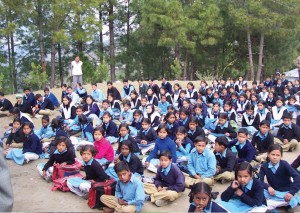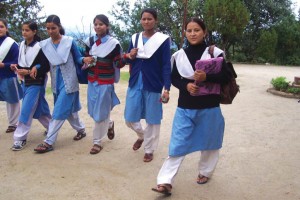 With 179 million students and 888,000 educational institutions, modernizing India’s education system is a huge challenge. The need of the hour is therefore a close collaboration between educationists and technologists; and open source provides the ideal framework for this process
With 179 million students and 888,000 educational institutions, modernizing India’s education system is a huge challenge. The need of the hour is therefore a close collaboration between educationists and technologists; and open source provides the ideal framework for this process
Napoleon once said that, “War is too important to be left to generals alone.” imilarly technology is too important to be left to technologists alone. By the ame token, education is too important to be left to educationists alone. Today,
we are on the cusp of an age that is being defined by the intersection of education and technology, particularly information technology. However, India faces a massive challenge in modernizing its education system. In a country that has 888,000 educational institutions, 179 million students and more than 2.9 million teachers modernizing the system is a task that requires innovative thinking and a radically new approach. In the 2005 budget, the Government of India embarked upon an aggressive plan of spending a bigger chunk of its GDP (approximately six percent) on modernization of education.In many villages and cities across India, millions of children have no access to basic educational facilities. At the same time, the basic structure of our society has changed from an ndustrial economy to one where the importance of knowledge pervades every action of ours. The billion dollar question that affects the lives of these 179 million students and the future of our 888,000 educational institutions therefore is—how do we modernize our education system at a time when we haven’t been able to deliver on the basic onstitutional promise of providing basic primary education to all Indians? The shifting structure of our society from an industrial economy to a knowledge economy offers us both a threat and an opportunity as we seek to modernize our education system. In a world where the creation anddissemination of knowledge are being rapidly digitized, it is inevitable thatIT will play a central role in the education system of the future. Classrooms of the future will not be mere brick and mortar structures imparting instructions but information hubs where knowledge is created and disseminated. This shift is very similar to the shift we see in the media where power is shifting away from “broadcast” media like print and television to the “interactive” medium of the Internet where individuals are not passive consumers of information but also producers of information. In the professional world a similar shift is happening with organizations placing a premium on employees who can think on their feet and execute tasks independently, as against those who merely follow instructions. If we wish to equip the next generation of Indian students for the knowledge economy, our education system needs to make a 180degree shift from a system that emphasizes rote learning and studious adherence to instructions to one that emphasizes creativity and encouragesinnovation and independent thinking. Our 179 million students (and 2.9 million teachers!) must not be passive “downloaders” of information but active participants in the process of creating and disseminating knowledge. If we deliver effectively on this vision of ushering our vast army of students into thedigital age, we lay the foundation for making India one of the superpowers of the 21st century. This is a challenge that should deeply engage India’seducationists and technologists and requires an interdisciplinary collaboration that has ever been seen before. The open source development model provides the ideal framework for this process. In the context of a developing country like India which is rich in talent but lacks the purchasing power of the west, open source offers several sustainable, long-term advantages as we seek to modernize our education system. The term “Open Source” originated in the world of software. At a simplistic level, the term represents software that is distributed along with the source code. Open Sourcesoftware programs are released with a liberal license that allow users to study the code, modify it and freely redistribute it. The philosophical underpinnings of Open Source sound very simple but the tenets on which open source is based—collaboration, community and the shared ownership of intellectualresources—has resulted in tremendous innovation. Moodle (www.moodle.org) an Open Source course management system was developed by an educator who found existing proprietary programs inadequate or expensive. It is now used by thousands of educational institutions to manage their coursework and s supported by an active community that develops and upgrades it. Since t has been developed by an educator himself, it enables a teacher to use Moodle to teach a course fully online or to supplement a course taught in traditional setting. In the world of software, Open Source has lead to the reation of world-class oftware like the Linux operating system, the Apache web rver and thousands of other software programs. Millions of people have contributed to the development of these programs and benefited from using hem. Linux, for instance, was released under the General Public License in 1991 and consisted of 10,000 lines of code. In a mere 14 years, due to the ontributions of open source developers across the world, this code-base has grown to 10 million lines of code. Linux now runs on everything from supercomputers to hand-held computers. It is estimated that if these 10 million lines of code were commercially developed, the cost would run into billions of dollars. Because Linux is available under an open source license, it is a community resource that is freely available to everyone. The Open Source philosophy has proved to be so popular that other disciplines are embracing the tenets of community, collaboration and shared ownership of intellectual resources with powerful results. The Open Source philosophy is catching on in the world of education content. For example, Wikipedia (www.wikipedia.org) has rapidly emerged as one of the largest online dictionaries in the world. In a short span of five years, Wikipedia has attracted five million entries fromacross the world in several languages and is a fantastic educational resource that we should localize to Indian languages. Because it is released under the open source, “Creative Commons” copyright, Indian educators have the freedom to translate Wikipedia into Indian languages and share it with theirstudents. The venerable, Massachusetts Institute of Technology took the radical step of “open sourcing” 1,100 courses online at http://ocw.mit.edu based on their conviction that, “the open dissemination of knowledge andinformation can open new doors to the powerful benefits of education for humanity around the world.” Other eb sites like Planet Math (www.planetmath.org)aim at creating communities of educators focussed on a specific domain to make knowledge more accessible. Many educational institutions themselves are now coming together to leverage the economic benefits of participating in Open Source development. For instance, leading
universities like the University of Michigan, Indiana University, MIT and Stanford are investing up to $1 million in staff time to develop producing open source Collaboration and Learning Environment (CLE) software. Even universities that are not members of the Sakai Project can download the software and interest in the Sakai Educational Partner Program (SEPP) is growing at the rate of 1-2 universities per week. Thus it is clear that whether it is for creating educational content, managing coursework and learning,
teaching a specific discipline or administration of an educational institution, the open source model offers tremendous benefits as a model for the creation and dissemination of knowledge. In a country where 888,000 educational institutions need to be modernized and more than 179 million students educated, the community ownership model of open source can help the country save billions of dollars that would be spent on proprietary operating
systems, software and content. Since anything developed under an open source model can be shared freely, it can help in the rapid dissemination of educational materials to India’s vast population of students. From a long-term perspective, it is important that the creation and dissemination of knowledge hould be a collaborative, community driven process rather than one that is
monopolized by a few individuals or companies. In the Indian, intellectual tradition, knowledge has always been considered as a common good treated
as a community resource rather than private property that can be monopolized and enjoyed by a few. The need of the hour is therefore a close collaboration between educationists and technologists. The open source
model provides a framework that can lead to an open source renaissance for Indian education.?





















